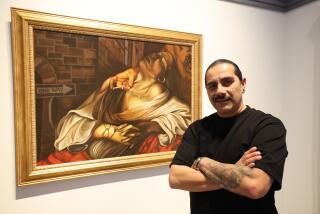How new shades of blue made ‘A Revolution of the Palette’ at Norton Simon
The creation of three shades of blue hues — Prussian, cobalt and ultramarine — in 18th and 19th century European art, spanning from the Rococo period to Impressionism, is the subject of a colorful exhibition at the Norton Simon Museum, “A Revolution of the Palette: The First Synthetic Blues and Their Impact on French Artists.”
“Previously, there were a limited number of options for oil painting,” noted conservator and curator John Griswold. “Common indigo blue pigment did not stand up in oil, often turning to mushy gray.”
The first breakthrough, dark blue Prussian, was the result of a laboratory accident around 1704. It was immediately popular with French artists because of its tinting strength and whole new range of green. “Its discovery also coincided with Isaac Newton’s color theory, which shifted discussion of color and light scientifically,” said Griswold.
ESSENTIAL ARTS & CULTURE NEWSLETTER >> Get great stories delivered to your inbox
Inspired by the blue glazes used on 18th century Sèvres porcelain, initially reserved for the aristocracy, chemist Louis Jacques Thénard developed a synthetic, vivid cobalt blue pigment making it affordable for the masses.
Considered the Holy Grail of pigments, ultramarine, derived from the rare semiprecious gemstone lapis lazuli, was once more expensive than gold. In 1824, the French government held a contest to find a cheap, accessible synthetic ultramarine. Artists finally had an affordable palate of cool and warm colors to fully replicate nature’s canvas. “The innovation of paint tubes around the same time made it possible to bring paint outdoors,” added Griswold.
Twenty-five objects from the museums collection, plus a vase and four rare editions on Newton, Voltaire and Goethe’s color theories borrowed from the Huntington Library, are on display through January.
SIGN UP FOR OUR ENTERTAINMENT NEWSLETTERS:
Indie Focus: Your field guide to only good movies
Classic Hollywood: A weekly email celebrating the Golden Age of Hollywood
Essential Arts & Culture: A curated look at SoCal’s wonderfully vast and complex arts world
More to Read
The biggest entertainment stories
Get our big stories about Hollywood, film, television, music, arts, culture and more right in your inbox as soon as they publish.
You may occasionally receive promotional content from the Los Angeles Times.






